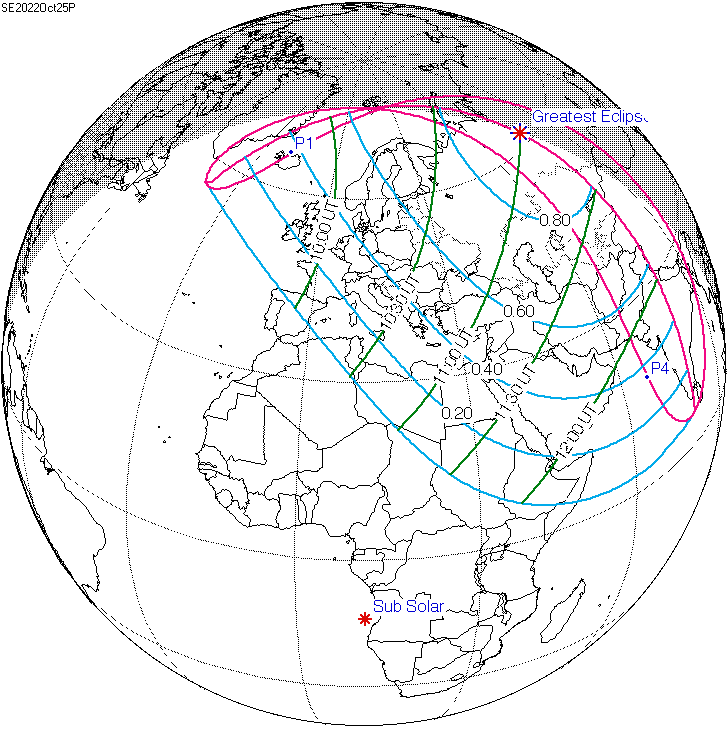"I'm on top of the world, looking down on creation
and the only explanation I can find is..."
THE SOUTHWORTH PLANETARIUM
70 Falmouth Street Portland, Maine 04103
(207) 780-4249 usm.maine.edu/planet
43.6667° N 70.2667° W
Founded January 1970
2022-2023: XXV
Sunrise: 6:45 a.m.
Sunset: 6:13 p.m.
Civil twilight ends: 6:42 p.m.
Sun's host constellation: Virgo the Maiden
Moon phase: Waxing gibbous (86% illuminated)
Moonrise: 5:10 p.m.
Moonset: 3:49 a.m. (10/7/2022)
Julian date: 2459859.21
THE DAILY ASTRONOMER
Thursday, October 6, 2022
October 2022 Night Sky Calendar Part III
__________________________
Happy Birthday, Alphertaz!
__________________________
FRIDAY, OCTOBER 21: VENUS AT SUPERIOR CONJUNCTION
Today Venus skirts behind the Sun relative to Earth, rendering it invisible. Of course, it's been out of sight and mind for about a week now and will remain hidden from view until year's end. Alas, do not despair, for Venus will rise again in the early evening skies in early - mid 2023!

This graphic shows the various orientations of an inferior planet. When at superior solar conjunction, an inferior planet is located on the far side of the Sun relative to Earth. When ai inferior solar conjunction, the planet moves between Earth and the Sun.
TUESDAY, OCTOBER 25: NEW MOON
Beginning of lunation cycle 1235.
TUESDAY, OCTOBER 25: PARTIAL SOLAR ECLIPSE!
[Not visible in the USA]
Inhabitants of Europe, North Africa, the Middle East and India will observe a partial solar eclipse today, This sort of eclipse occurs when the moon partially blocks the Sun. The maximum eclipse point is located in West Siberia. Observers outside this region, but within the eclipse viewing boundaries, will see an eclipse of lesser magnitude. [Magnitude in this instance refers to the percentage of the Sun's diameter obscured by the moon.] See graphic below courtesy of Fred Espenak.

We're mentioning this partial solar eclipse because it is associated with the November 8th total lunar eclipse. A lunar eclipse occurs either two weeks before or two weeks after a solar eclipse. Although we won't see any of this solar eclipse, we'll at least observe the first phases, including part of totality. Much more on THAT event in next month's night sky calendar.
PLANET WATCH
MERCURY
This fleet footed, sun-baked, petit little world veers up in the eastern pre-dawn sky at month's beginning and remains visible throughout most of October. However, toward the end of the month, it vanishes below the eastern horizon as it prepares to move into superior solar conjunction on November 8th, VERDICT: The best time to see Venus is, well, just about now! As Mercury will reach greatest western elongation on 8th, this week is the most favorable for Mercury glimpsing. Venture out just after 5:30 to find this elusive little planet. Unobstructed eastern horizons required.
VENUS
[Host constellation: Virgo the Maiden]
Not a great month for Venus! It begins the month of October very low in the eastern pre-dawn sky, but will soon disappear before reaching superior solar conjunction on October 22nd. VERDICT: Venus can't beguile the senses if she doesn't show up. Give it a miss this month. Venus will just peek up into the western evening sky toward the end of December and will shine fiercely and beautifully in the winter, spring and early summer sky.
MARS
[Host constellation: Taurus the Bull]
What a gorgeous sight Mars has become! As the red planet draws ever closer, its light grows ever brighter. At month's beginning, Mars shines at magnitude -0.6, making it brighter than Alpha Centauri (not visible here.) By the end of October, Mars will brighten to magnitude -1.2, making it nearly as bright as Sirius. VERDICT: As Mars rises after 9:30 p.m. at month's beginning and by 7:30 p.m. at the end of October, it will become easier to see later in the month. However, it will dazzle and delight when seen earlier. Remember that it looms above Orion!
JUPITER [PICK PLANET!]
[Host constellation: Pisces the Fish]
Last month Jupiter was brighter than it had been in about sixty years! This month the mammoth planet is almost equally brilliant despite its increasing distance from Earth. As Jupiter was at opposition on September 26th, it will ascend progressively higher in the eastern early evening sky. VERDICT: Heavens above, it would be difficult to miss Jupiter. Look for that blazing beacon in the eastern evening sky,
SATURN
[Host constellation: Capricornus the Seagoat.]
If planets had egos as large as those of their Olympian namesakes, Saturn's would have been battered into a pasty pulp by now. Saturn is that moderately bright planet to the northwest of the considerably brighter, larger, lovier and far more admired Jupiter. Saturn is the sight one sees when one tires of beholding Jupiter rapturously. VERDICT: Give Saturn at least a passing glance, if merely to assuage the grief it might feel at its cruel neglect.
To subscribe or unsubscribe from the Daily Astronomer: